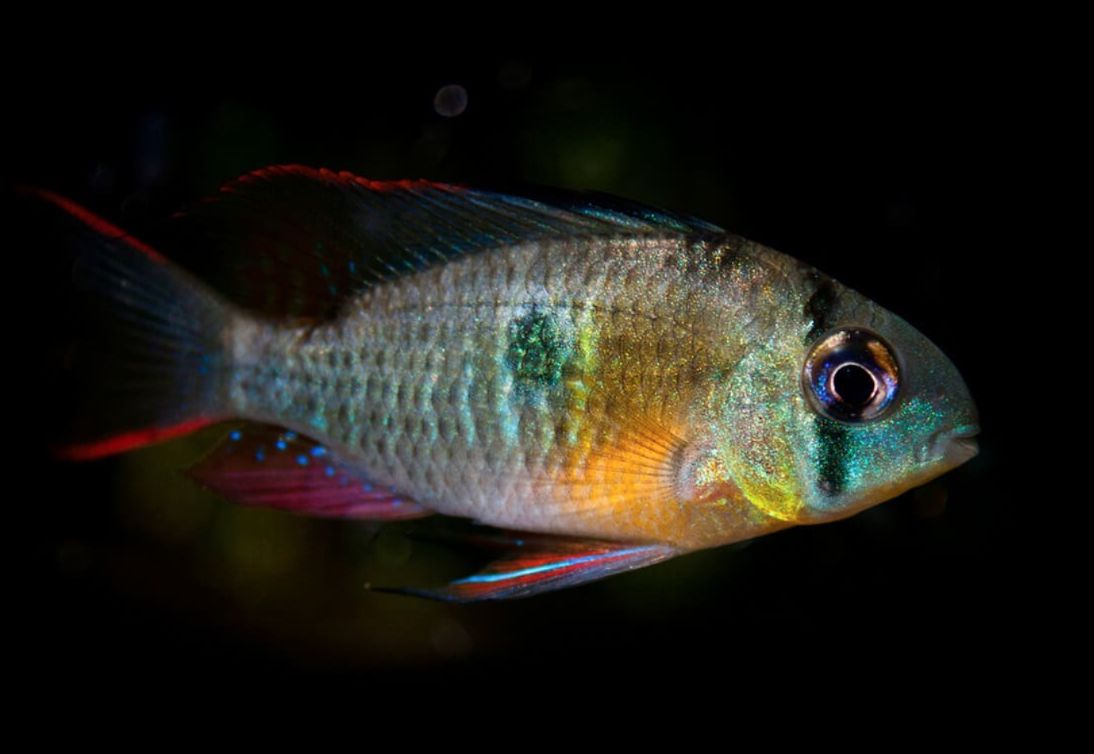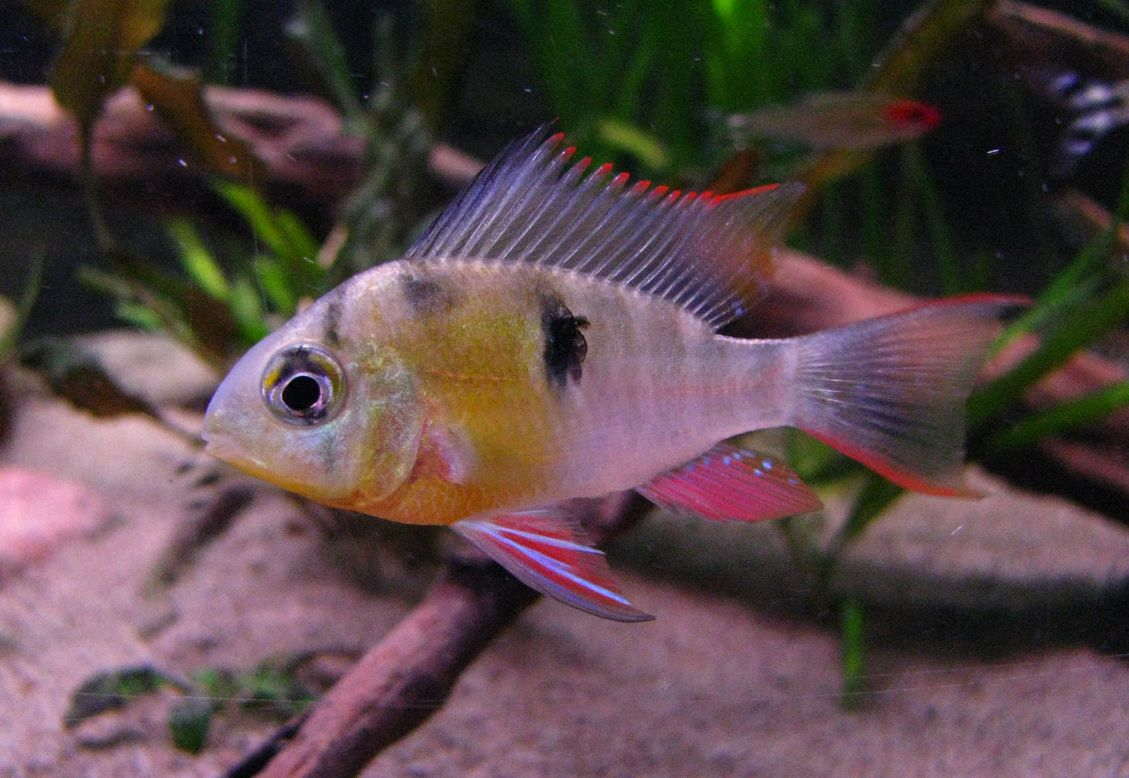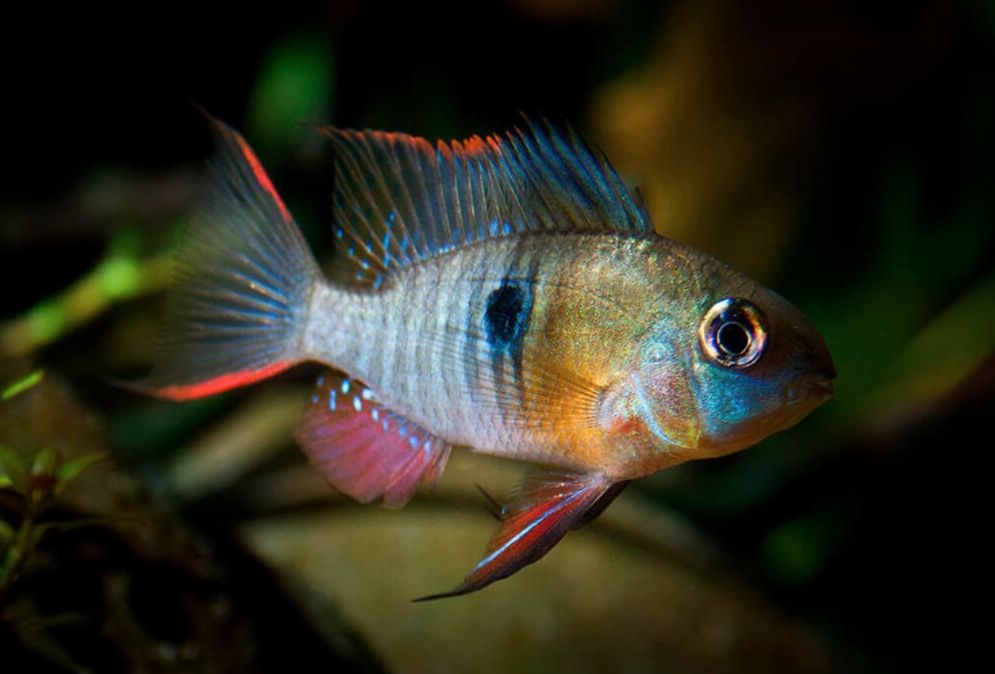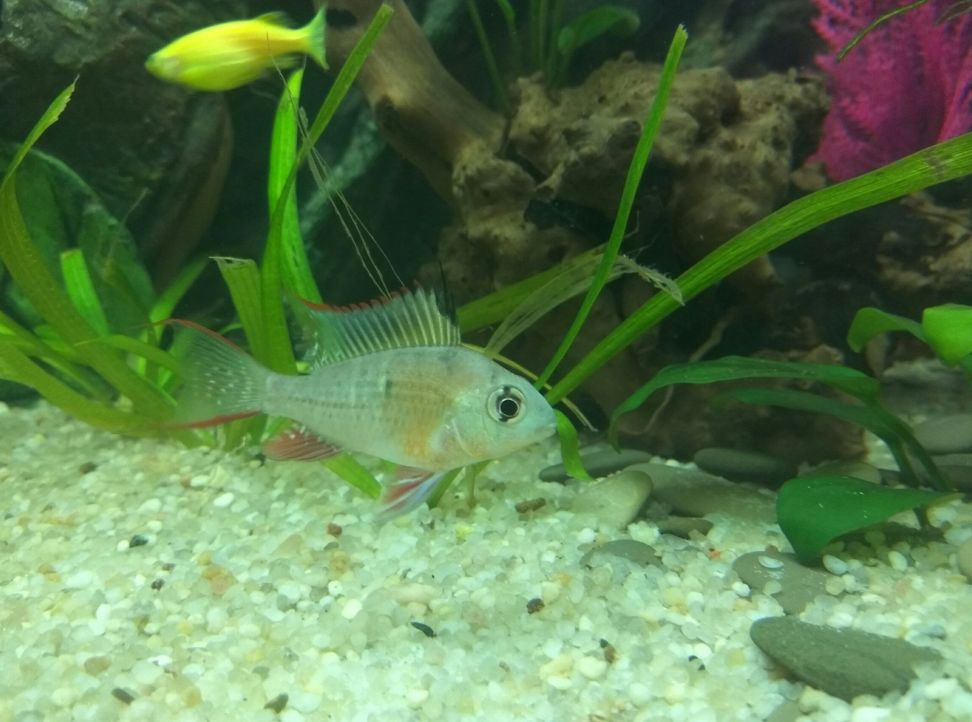The Bolivian Ram (Mikrogeophagus altispinosus), also known as the Bolivian Butterfly or Bolivian Ram Cichlid, is a popular aquarium fish known for its vibrant colors and peaceful temperament. Bolivian ram cichlid (lat. Mikrogeophagus altispinosus) is a small, good looking and peaceful cichlid. Keeping bolivian ram is quite easy, it is a proper choice for community tanks. The fish is a bit more aggressive than its relative – ram cichlid, though if comparing it with cichlid species in general it’s not aggressive at all. Its behavior is meant more to scare the other fish, not no attack or hurt.

Contents
Habitat in the wild
The Mikrogeophagus altispinosus is a species of freshwater fish that is native to the rivers and streams of North and North-East Bolivia as well as Brazilian state Mato Grosso. They are commonly found in the upper Paraguay River basin and the Mamoré River system.
The bolivian ram dwells in river tributaries, backwaters and lakes with sandy and muddy bottom; usually it prefers shallow and slow waters with lots of snags and luxuriant vegetation. They prefer areas with sandy or gravel substrates and plenty of hiding places such as rocks, driftwood, and plants.

Description
Color
The bolivian ram has large head and eyes (they have black edging). The dorsal fin is tall and transparent; it has red edging on top. The tail fin has elongated rays. The main color of the body is yellowish, its head and chest are orange colored. The males have one dark almost black spot on their body side and the females have two of them. There is a dark stripe over the eye. Horizontal gray stripes begin from the spots on the body sides and they end near the tale; their number may vary within 7-10 stripes.
Size
How big do bolivian rams get?
The bolivian ram maximal size is up to 8 cm (3.1 in); but usually the males are about 6 cm (5.4 in) long, the females are a bit smaller – about 5—5,5 cm (2 in).
Lifespan
How long do bolivian rams live?
The average lifespan of bolivian rams is typically around 3 to 5 years in a well-maintained aquarium. However, with proper care, a healthy environment, and optimal nutrition, some individuals may live longer, reaching up to 6 or even 7 years.
| Characteristic | Description |
|---|---|
| Scientific Name | Mikrogeophagus altispinosus |
| Common Names | Bolivian Ram, Bolivian Butterfly, Bolivian Ram Cichlid |
| Adult Size | 8 cm (3.1 in) |
| Lifespan | 3-5 years |
| Temperament | Peaceful, can be territorial during breeding |
| Difficulty Level | Moderate |
| Water Parameters | pH 6.0-7.5, Temperature 75°F-82°F (24°C-28°C) |
| Water Hardness | Moderately soft to moderately hard (dGH 5-15) |
| Tank Size | Minimum 20 gallons (75 liters) for a pair |
| Diet | Omnivorous, accepts high-quality pellets, flakes, and live/frozen foods like brine shrimp, bloodworms, and daphnia |
| Tank Region | Middle to bottom of the aquarium |
| Preferred Substrate | Fine sand or smooth gravel |
| Plant Compatibility | Tolerates live plants, may dig in the substrate |
| Compatibility | Peaceful community fish, avoid larger/aggressive species |
| Gender Identification | Males typically larger with extended dorsal and anal fins, females have a pinkish belly during breeding |


Difficulties in keeping
Are bolivian rams hardy?
Mikrogeophagus altispinosus are generally considered to be hardy aquarium fish. They are more forgiving and adaptable compared to some other species of cichlids.
Do bolivian rams eat plants?
In most cases, bolivian rams will not actively seek out and consume healthy live plants as a significant part of their diet. They are omnivorous and primarily feed on small invertebrates, insects, crustaceans, and plant matter in the wild.
Technically it can be kept in a community tank, especially if you don’t have experience in keeping of any cichlid species. This one is rather hardy and standard tank maintaining procedures will be enough for this fish to live there successfully.
Also it eats all types of food and what is the most important – if compared to other cichlid species, the fish is very good-tempered and doesn’t damage tank plants.
Care and keeping in a tank
Tank size
It is recommended to provide a tank size of at least 20 gallons (75 liters) for a pair. However, a larger tank is preferable, as it provides more swimming space and allows for better territorial divisions. Optimal tank capacity for a group of 6–8 species starts from 200 liters (44 gallons). Overall, the more space you can provide for Bolivian Rams, the better it will be for their health, comfort, and natural behavior. Use sandy bottom substrate, several snags and put tank plants in certain sections of the tank bottom to leave some empty areas there.
Tank decor
It’s important to note that while bolivian rams are generally peaceful, they can become territorial, especially during breeding or if the tank size is too small. Providing ample hiding spots, visual barriers, and creating territories with appropriate decorations can help reduce aggression. The main thing is that the tank mates are no threat to bolivian rams and they don’t compete with it for the shelters and near-bottom area. When competing with fishes of equal size and temper, fish can take a stand for itself.
Tank plants have to be thickly planted and create shadowed areas as well as to leave some space for the fish to swim. These fish species require lots of shelters. For this purpose you can use stones, snags, artificial caves and rock shelters. A pair of large flat stones may become a place for spawning in the future.
The bolivian ram likes dim scattered light which you can provide by placing some floating plants on the tank water surface.
Water parameters
This cichlid isn’t that demanding in terms of water quality as ram cichlid, therefore it can do with some nonessential mistakes or forgetfulness of its owner when maintaining the tank conditions.
It’s desirable to keep bolivian ram in a tank with stable water parameters and pH 6.0-7.5, hardness 5 — 15 dGH, water temperature 23-28 °C (73,4-82,4°F).
Bolivian ram prefers soft and slightly acidic water. Successful long-term keeping of the fish to a large extent depends on filtration system performance and tank cleaning procedures frequency: weekly water renew (10–15% of the total tank volume) with the fresh one and removing organic waste.
Diet
The bolivian ram is omnivorous and undemanding. Bloodworm, daphnia, tubifex, artificial food – the fish eats all of it with unfailing appetite. At that you can feed the fish both with live and frozen food.
To ensure that the fish demonstrates its brightest coloring you should include specialized food into the diet. Offer a staple diet of high-quality pellets or flakes specifically formulated for cichlids. Look for options that contain a balanced blend of protein, vitamins, and minerals suitable for small to medium-sized cichlids.
Tank mates
Mikrogeophagus altispinosus are generally peaceful fish that can coexist with a variety of compatible tank mates. It is compatible with schools of small sized Characidae species, which in the wild are ram constant companions and at the same time they signalize that there are no predators around. The bolivian ram shows no interest at all towards other tank dwellers, that’s why fishes from almost any biotopes can make a company for bolivian ram.
Here’s a list of small-sized species that are popular in the aquarium hobby:
- Neon Tetra (Paracheirodon innesi)
- Cardinal Tetra (Paracheirodon axelrodi)
- Glowlight Tetra (Hemigrammus erythrozonus)
- Ember Tetra (Hyphessobrycon amandae)
- Black Neon Tetra (Hyphessobrycon herbertaxelrodi)
- Green Neon Tetra (Paracheirodon simulans)
- Rummy Nose Tetra (Hemigrammus rhodostomus)
- Flame Tetra (Hyphessobrycon flammeus)
- Cherry Barb (Puntius titteya)
- Harlequin Rasbora (Trigonostigma heteromorpha)
- Lambchop Rasbora (Trigonostigma espei)
- Dwarf Pencilfish (Nannostomus marginatus)
- Glowlight Rasbora (Trigonostigma hengeli)
- Celestial Pearl Danio (Danio margaritatus)
- Endler’s Livebearer (Poecilia wingei)
- Pygmy Hatchetfish (Carnegiella myersi)
- Tiger Barb (Puntigrus tetrazona)
- Rosy Barb (Pethia conchonius)
- Gold Barb (Puntius semifasciolatus)
- Odessa Barb (Puntius padamya)
How many bolivian rams should be kept together?
The bolivian ram is peaceful and calm, it prefers being in a group of 6-8 species of its kind. A ratio of 1 male to 2-3 females is recommended to minimize aggression and create a more natural social dynamic. Keeping a single male and a single female together is a common setup for breeding purposes. A pair will form a bond and engage in courtship and spawning behaviors. It’s essential to ensure that the female has enough space and hiding spots to retreat to if the male becomes overly aggressive during breeding.
Conflicts arise inside the fish school from time to time, but they are completely harmless: it never comes to fighting till death or even damaging fins. Usually bolivian ram male species initiate the fights, since they try to use any chance to prove their right to set their position in the hierarchy as well as to claim getting the higher one. Sometimes if the male fails to conquer more successful and strong rival, it may try to retrieve the defeat on females. But they, as a rule, don’t participate in any fights and wisely hide among the tank plants.
However, don’t forget that still it is a cichlid, though it is small. It will prey on juveniles, very small fishes and cherry shrimps, since this is its instinct.
Can bolivian rams live with angelfish?
Bolivian Rams (Mikrogeophagus altispinosus) and Angelfish (Pterophyllum scalare) can potentially coexist in the same aquarium. Bolivian Rams and Angelfish prefer similar water parameters, such as slightly acidic to neutral pH and relatively warm water. Keep in mind that Angelfish can grow larger than Bolivian Rams. Avoid keeping them together if the size difference is significant, as larger fish may view the smaller ones as potential prey.

Gender differences: male vs female
The bolivian ram becomes reproductive at the age of 9-10 month and at that it is 4-6 cm long. Young species have no gender dimorphism.
Here are some characteristics that can help distinguish between male and female bolivian rams:
Male:
- Size: Males tend to be slightly larger than females, with a more elongated body shape.
- Dorsal and Anal Fins: Males have more extended and pointed dorsal and anal fins compared to females. These fins are often more pronounced, especially during courtship and breeding.
- Coloration: Males typically display more vibrant and intense colors. Their overall body coloration can be more intense and their fins may have more vivid patterns and markings.
- Throat and Belly: During the breeding season, males often develop a more intense red or orange coloration on their throat and belly. This coloration is used to attract females and establish territory.
Female:
- Size: Females are generally slightly smaller and have a rounder body shape compared to males.
- Dorsal and Anal Fins: Females have shorter and rounder dorsal and anal fins compared to males.
- Coloration: Females usually have less intense coloration compared to males. They may display softer or more subdued hues.
- Throat and Belly: Females may exhibit a pinkish or pale yellow coloration on their throat and belly during the breeding season. This coloration is less vibrant compared to the intense red or orange seen in males.
Breeding
Forming the couple turned out to be the biggest problem in terms of breeding. Male and female chosen at random very often don’t want to breed together.
At best the bolivian ram simulate spawning or on the 2nd or 3rd day after they lay eggs they eat them. An ideal option is to let the fish choose a partner themselves and to do this you’ll have to grow adult species from a school of 8-10 young species.
Though this drawback has an advantage as well: the couples they form are stable. Later you can put them into another tank, give to your friends and so on – and the couple doesn’t break up.
If a community tank isn’t overcrowded and the bolivian ram has enough of shelters and potential places to lay eggs (caves, large stones, pebbles, ceramic and plastic tubes or at least smooth large snags and even wide leaves of tank plants) there is no need to put the fish couple into a separate volume for spawning, especially if you don’t breed the fish for sale.
If it is impossible to preserve offspring in an ornament volume (for example, in presence of a school of tiger barb which definitely won’t let juveniles survive) put the breeders into a spawning tank of 50 liters capacity with water heated to 26-28 °C with the following parameters: dGH до 10°, pH 7-7,5.
Naturally, the longer bolivian ram is bred in captivity the less the fish depends on chemical water parameters.
Spawning tank should contain 3-4 lush bushes of small leaved tank plants, a round flat stone and small grained bottom substrate. If you plan to incubate the eggs on your own, the substrate is not necessary in this case. But if it is present, the fish feel more confident and comfortable, faster get used to a new tank and start breeding.
First of all the bolivian ram couple starts to clean a place for their future clutch. Both parents participate in the process; it can take from 2 days to a week. Only after they finish cleaning the place for spawning, the fish start to lay eggs. The fish may not lay eggs during the first two-three passages above the spawning place.
This is especially typical for those species which are spawning for the first time, but sometimes the female starts to lay eggs at once. After sticking a line of 10-20 yellowish eggs to the spawning substrate, the female swims a bit aside and the male fertilizes them.
The eggs lie quite tightly both firmly stuck to the stone and to each other. A year old female usually lays 80-100 eggs; three year old one lays about 150-200 eggs and the whole process takes from 40 minutes to one hour.
Young inexperienced bolivian ram not always spawn successfully for the first time. Often almost all eggs appear to be not fertilized or the parents eat all the eggs without with no apparent cause or sometimes they even eat the larvae as well.
Don’t despair! Provided with favorable keeping conditions and care you can expect the spawning to occur again in 3-4 weeks and it has to be more successful this time.
The egg stage lasts about 3-4 days depending on the tank water temperature. During all this time the female takes care of the clutch sterility, the male swims around the territory border he defined guarding the female and future juveniles from a potential aggressor.
On the 5th day the bolivian ram larvae hatches (they are very small and almost motionless). The parents move them many times for the next 4-5 days from one place to another putting them on some proper surfaces or into the pits in the substrate they dig in advance.
Sometimes, bolivian ram lays eggs not on a stone, but into such a pit in the substrate. This is another reason why you should put some substrate on the tank bottom.
Once the juveniles start to swim, you can put the adult species back into the community tank and put a portion of fresh brine shrimp nauplii, Vinegar eels etc. into the spawning tank.
If your priority is watching the fish behavior and not the number of the juveniles obtained, you can leave the parents and the offspring together in the tank. But be ready that during the next 3-4 weeks the parents will zealously raise their juveniles.
They will have no mercy to those whom they consider inviable (as a rule, in the end the latter compose almost 2/3 of the total juveniles number).
You can keep the bolivian ram juveniles in the spawning tank for about 2-3 weeks and after that, when they are about 1.5 cm long you should put them into more spacious tank.
Otherwise, especially if there are many of them, the rate of their growth will slow down and there will be more species with various pathologies. The juveniles bear heavily excessive amount of nitrogen containing compounds, that’s why it is necessary to equip the tank with powerful filter and renew the water more often.
When the juveniles become two month old you can feed them with what adult fish eat and in a month or two you can put them into the community tank.